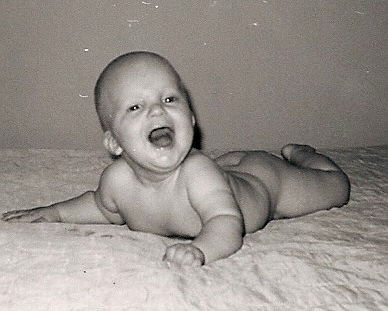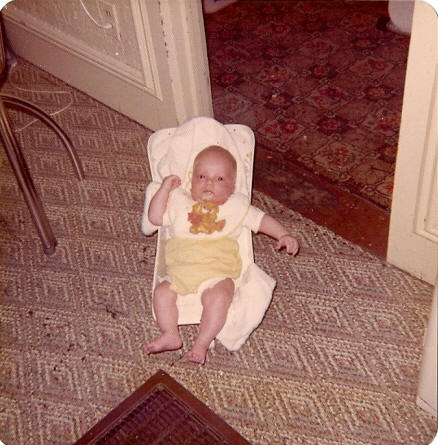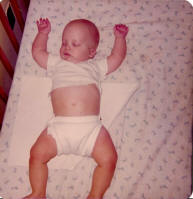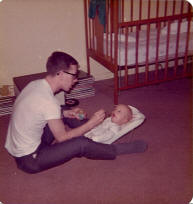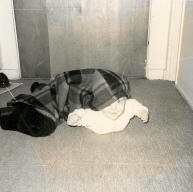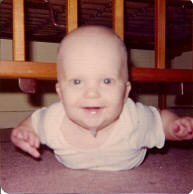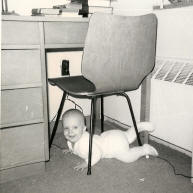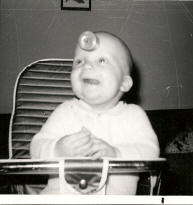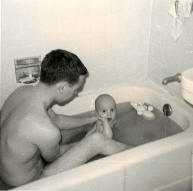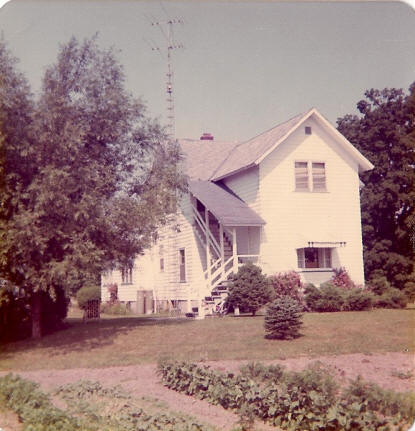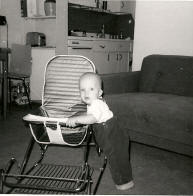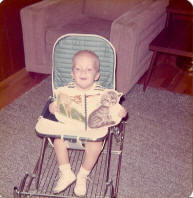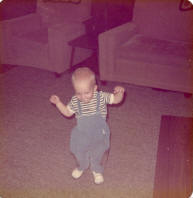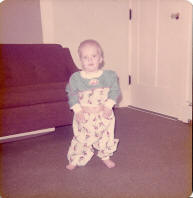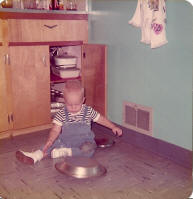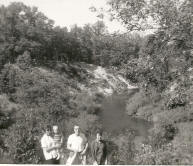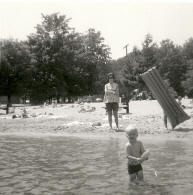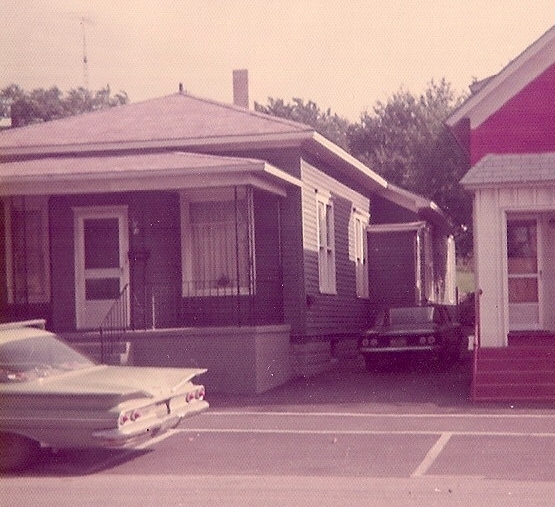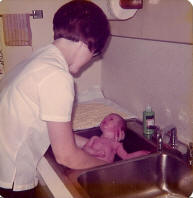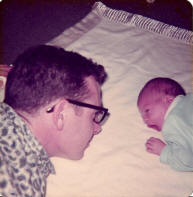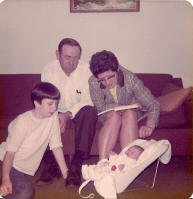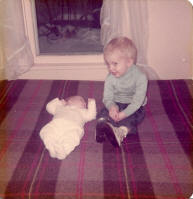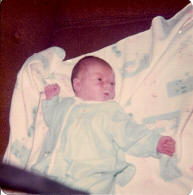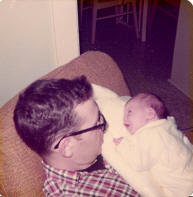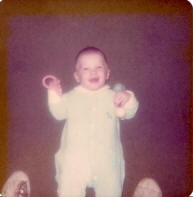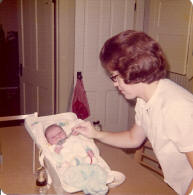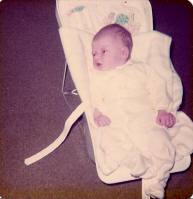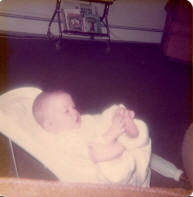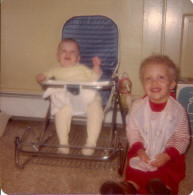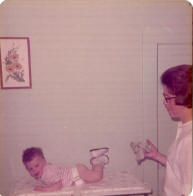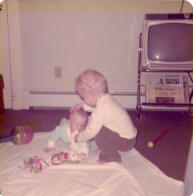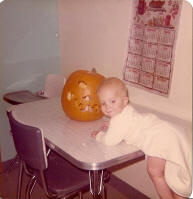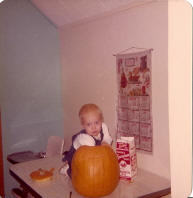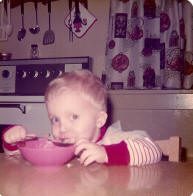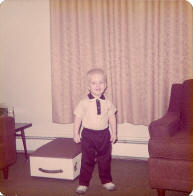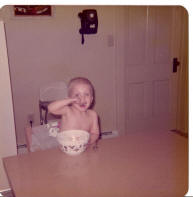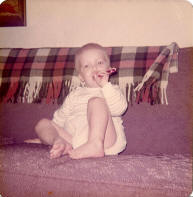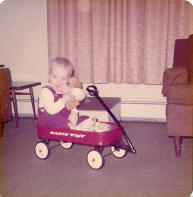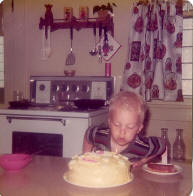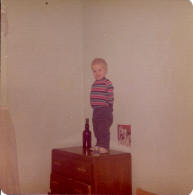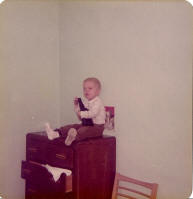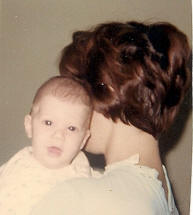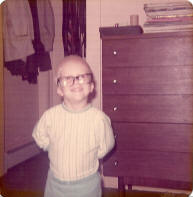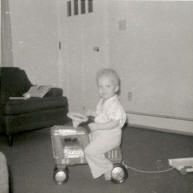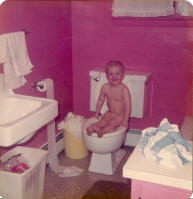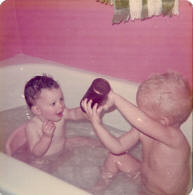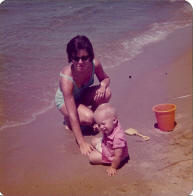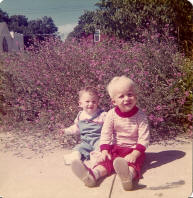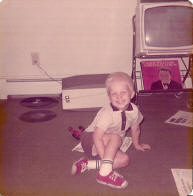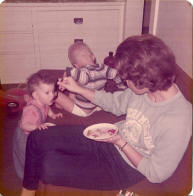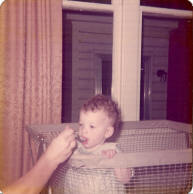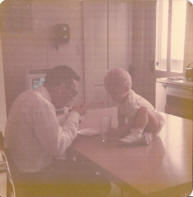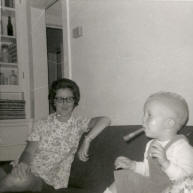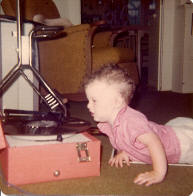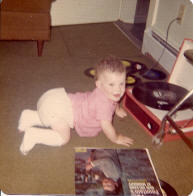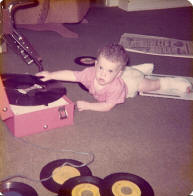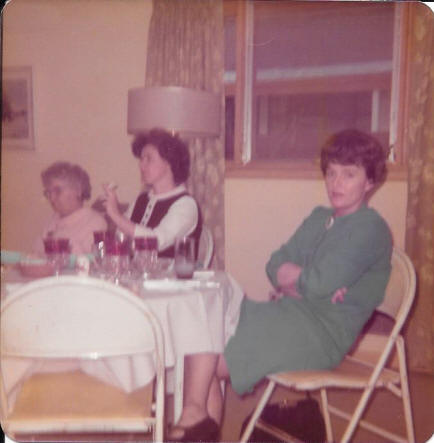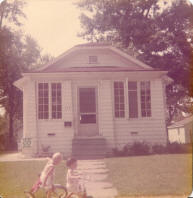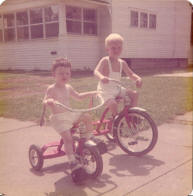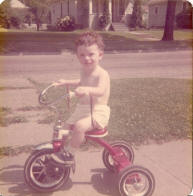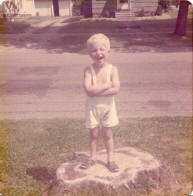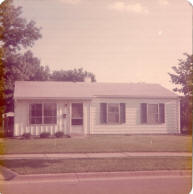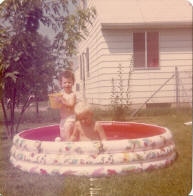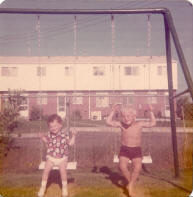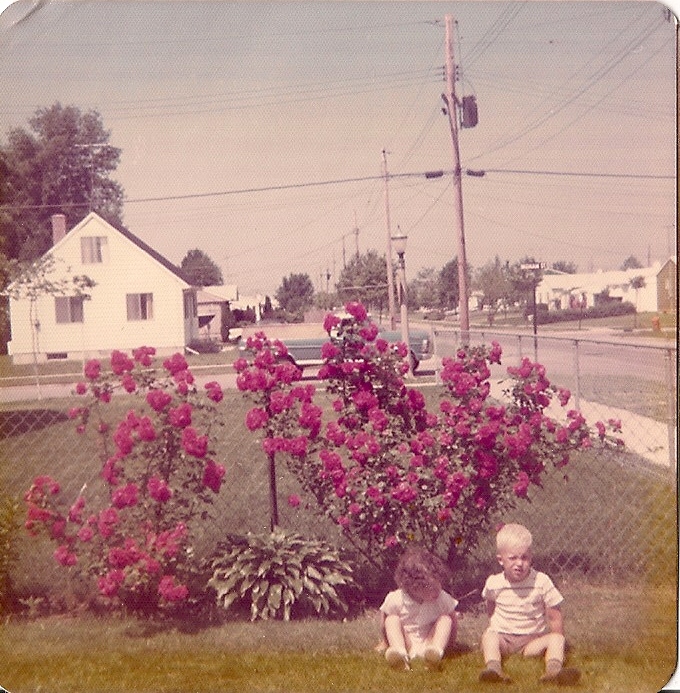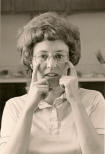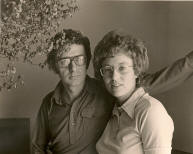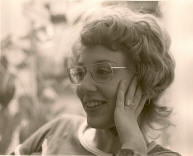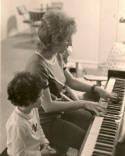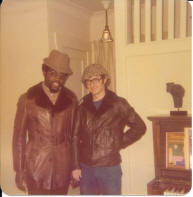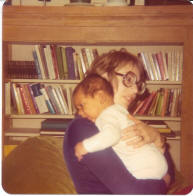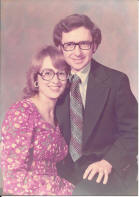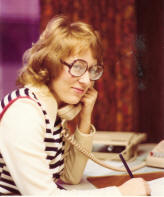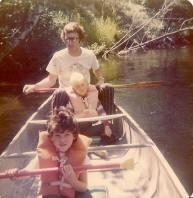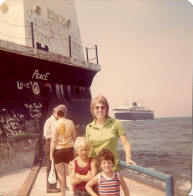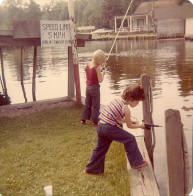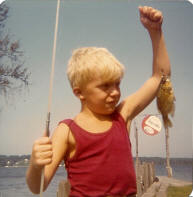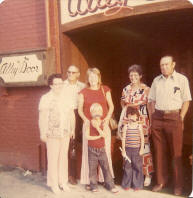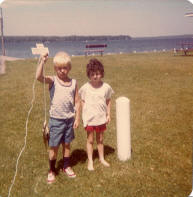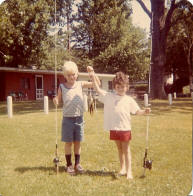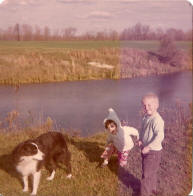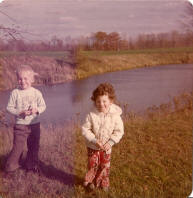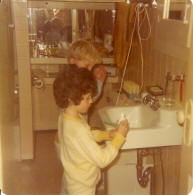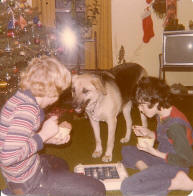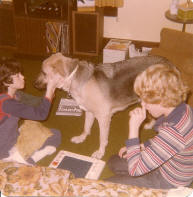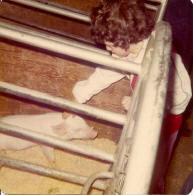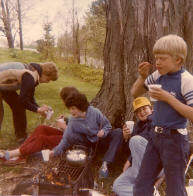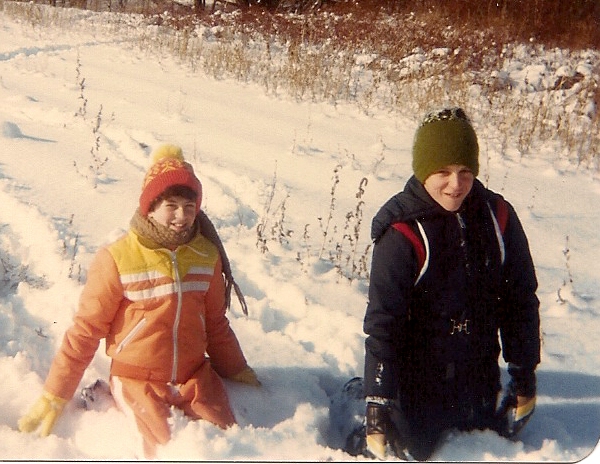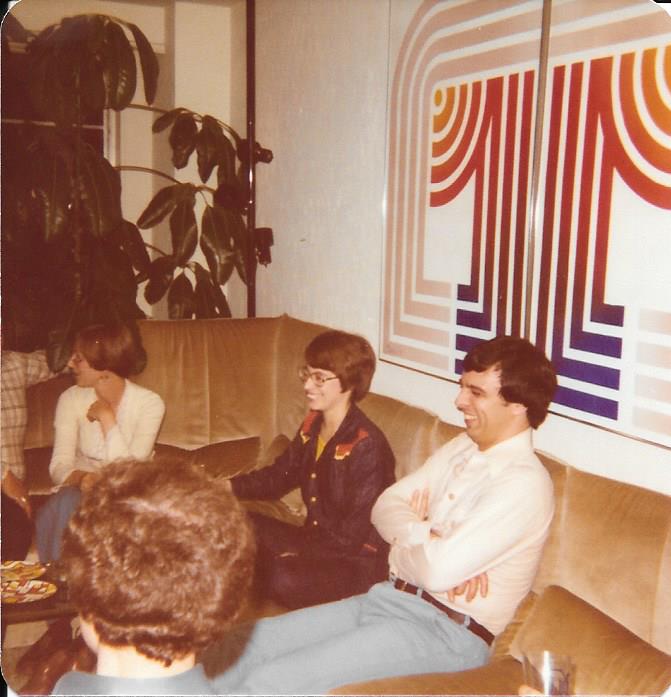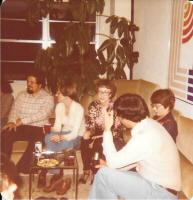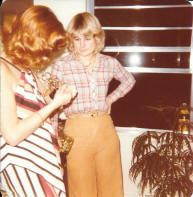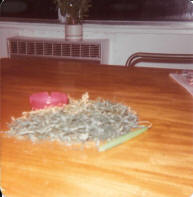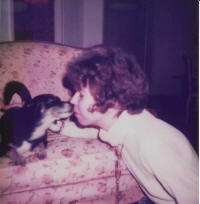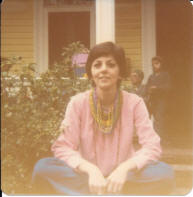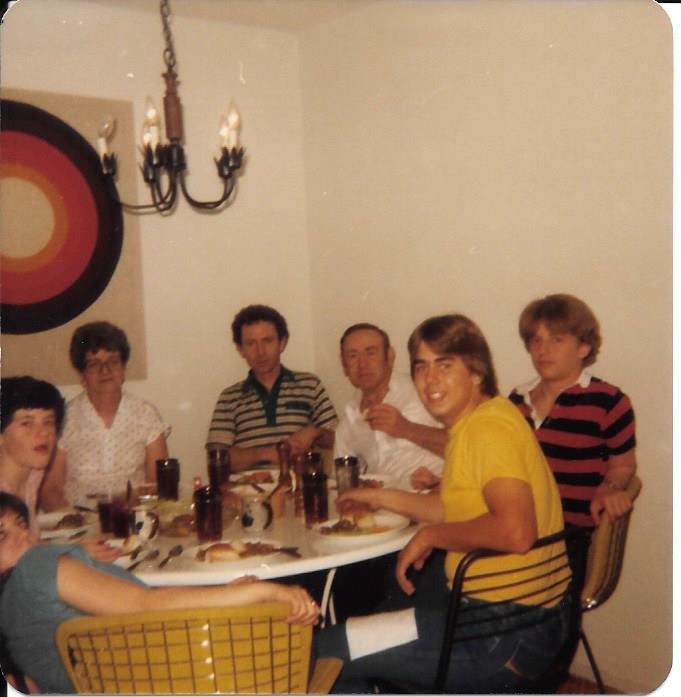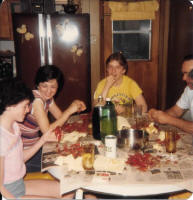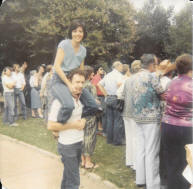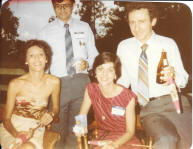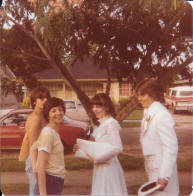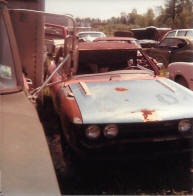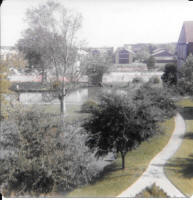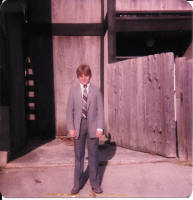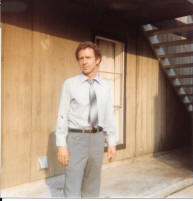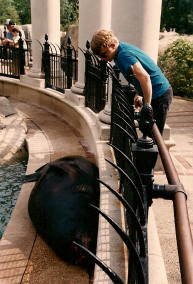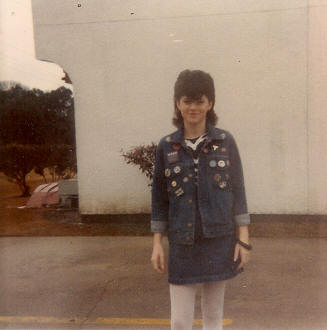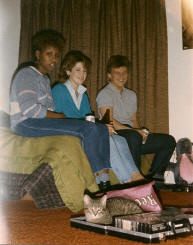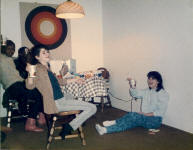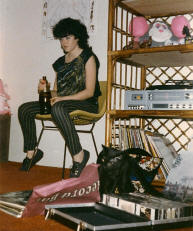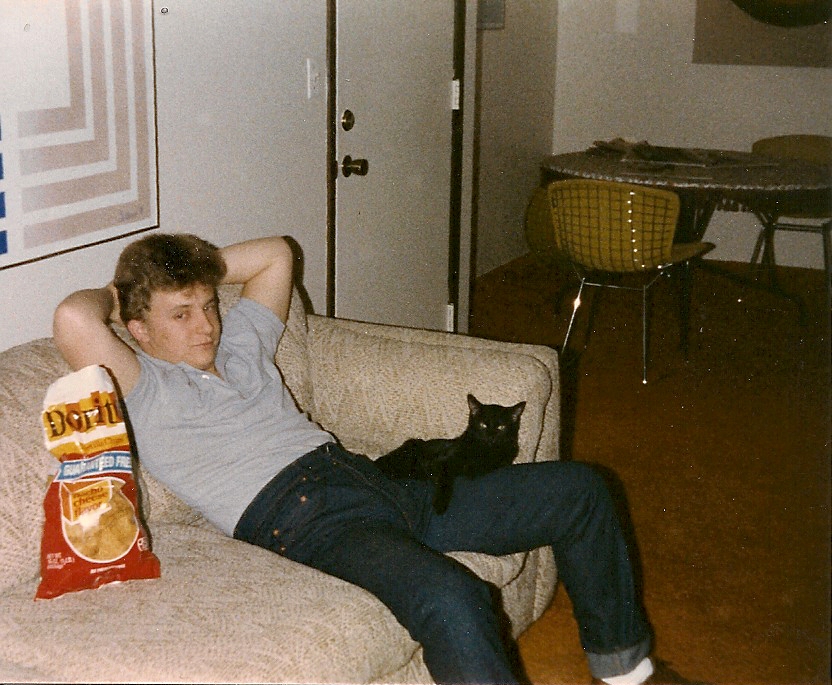| Marriages, Kids, Jobs 2018
After my junior year at Michigan State University, I returned home to South Haven to run Harrys' Fruit Stand, as I had for the previous 4 years. That summer, cousin David Goff was dating Karen Knapp. Karen's older sister, Kathy, was in the class behind mine at South Haven High. Dave fixed us up. Toward the end of September, just before I headed back to MSU, we leaned that we were expecting. When I told my parents that I was dropping out of school to get a job, they disagreed, saying I should return to school and they'd help financially. We were married by a justice of the peace in East Lansing with 2 fraternity brothers as witnesses. Our first apartment was the upstairs of a house on Bensch Street, a short walk from Potter Park in Lansing. We later lived in an upstairs apartment on Bingham Street, not far from Sparrow Hospital. (Or maybe it was the other way around.) Tom was born in early June, 1965. I remember him lying on his back in the hospital with big, wide eyes, like he was thinking "What place is this?" Soon after, we packed up and moved to South Haven, where I ran Harrys' Fruit Stand for one last summer. This picture was taken in the upstairs apartment we rented. The apartment was pretty shabby. Baby Tom was getting bitten by fleas that apparently were thriving on the owner's dogs downstairs. When we returned to MSU in the fall, we lived in Spartan Village on campus, where these pictures were taken:
After graduation, I got a job as a caseworker with the Mason County Department of Social Services in Ludington. The only requirement was a bachelor's degree, and mine was in Spanish. We moved into an upstairs apartment in a farmhouse a few miles east of town, on Conrad Road. This was in March 1966. I think it was here that Tom took his first steps. He enjoyed pulling pans out of the cupboard and dropping them so they slowly spun to a stop. He liked the sound they made. Our landlady downstairs probably did not.
It was here one day that Kathy started feeling sick and dizzy, falling in and out of consciousness. I carried her down that outside stairway, put her and Tom in the car, and drove to our doctor's office in Ludington. I carried her in, and after looking at her briefly, the doctor told me to take her directly to the hospital (which I should have known to do in the first place.) He called Dr. Castellani, a surgeon, and told him to be prepared to meet us. (I don't remember our family doctor's name.) The hospital was on south Washington Avenue. Kathy had a ruptured ectopic pregnancy and was bleeding internally. She recovered, and not too long after that was pregnant again. The picture at the left was taken along the Pere Marquette river, probably east of Scottville, which is 10 miles east of Ludington. With Kathy and Tom are Jim and Evelyn DeVries, a couple we socialized with. Jim worked with me at Social Services. The picture at the right was at the beach in Ludington. A year or so after Kathy's surgery, a new hospital was built on Ludington Avenue. That is where Amy was born in November 1967, shortly after we moved to an apartment in town, at 903 S. Washington. It was a one-story house divided into 2 apartments, front and back. Ours was the one in back. It was a nice little apartment. Our car was a used Chevy Corvair I'd bought before we moved to Ludington from my uncle Ashley, who owned a Chevy dealership in Mason (city of). I put cement blocks on the floor in front of the back seats, laid a piece of plywood over them the same height as the seats, and then covered the whole area with a blanket. That way, we could just toss the kids back there and let them tumble around. This was before child safety seats.
Amy and Tom were both music fans and especially liked the Beatles (the album we see above, however, is Pete Fountain). They'd sit together on the sofa listening to music, rocking back forth against the sofa back. I had a couple hobbies while we lived here. One was collecting old bottles, mostly found poking around old abandoned buildings in the countryside. The apartment had a nice, built-in cupboard with glass doors to display them.
The other hobby was aquatic insects. I kept them in an aquarium on top of a dresser in the bedroom. (I don't have a picture.) That carried over from an introductory entomology course at MSU. The aquarium was covered with a screen, but some of those insects could fly, and occasionally escaped. I remember finding a predacious diving beetle in the bed. Kathy was not nearly as enthusiastic about them as I. At that time, the Social Services offices were in the lower level of the county courthouse on Ludington Avenue. This photo is from Google maps:
Here are some of the people I worked with. At the left is Vera Christianson, next is director Tom Hanson's wife, and last is Phoebe Stapleton. Phoebe was fun; she lived in Manistee and had about 7 kids. Tom Hanson was the second director we had while I was there. The first was Helen Gust; second was Tom Hanson, who left to direct Bay County Social Services; and third was Paul Hendrikson, who later became director of Muskegon County Social Services.
One day I was away from my desk and someone came and got me, saying I had a visitor. I returned to my office to find son Tom at my desk. He had walked all the way from home, about 13 blocks. He couldn't have been more than 3 years old. Kathy hadn't missed him. I was restless after about 2 and half years and in October 1968 managed to get a caseworker job with Ingham County Social Services back in Lansing. The department was in a new, U-shaped, one-story building on Executive Drive, off south Pennsylvania. After only a few months as a caseworker, the position of intake supervisor opened up, and I got it. I've talked about that time in a separate story. Our first home was a rented house on Barnes Avenue, near Mt. Hope and south Washington. Mostly I remember the sewage backing up in the basement.
After a while, we bought a house on Hillcrest in southwest Lansing. It was a one-story pre-fab. We noticed that the kitchen floor slanted a little. Years later, there was a story in the Lansing State Journal that said the house was sinking. The guy I'd sold it to wasn't too happy about it. It had to be bulldozed.
I wasn't happy in the marriage and envied the freedom of the single people I worked with at Social Services. I told Kathy I was leaving; she chose to leave instead, and moved back to South Haven with the kids. They lived with her mother for a while in her house in the the northeast corner of Monroe Park, and then moved to a rented home a few blocks away. That marriage lasted 5 years. I stayed in the house on Hillcrest, sharing the cost with a couple of single guys who worked at Social Services: Alan Jansen and Phil Michael. Alan was divorced and had a small son; Phil was a bachelor. In January 1971, I got a job in the Social Services central office in downtown Lansing, at the southwest corner of Capitol and Washtenaw. At that time, the building was called the Commerce Center; now it is WMU Cooley Law School. The job was writing procedures for a new online system for managing case records, making payments, etc. Up until then, transactions were done by shipping paper forms from the counties to the state office, where they were keyed and then batch processed. The new system was eventually called the Client Information System, CIS, and it was a long way from today's online systems. Caseworkers in the counties didn't have PCs or terminals on their desks. They prepared transactions on paper as before, called an operator who sat at a terminal in the state office, and read the information as he/she typed it in. To write procedures, I had to learn how the system worked, and in the process got an introduction to computers and data processing. As it turned out, that knowledge combined with my familiarity with processes in the county offices enabled me to make useful suggestions to the system designers. So I was not only explaining the system to the workers in the counties - by way of a procedures manual - but explaining the needs of the county offices to the systems people. That got to be such a necessary function that I needed help; I became a supervisor with staff. I wrote about those times here. A while after the divorce from Kathy was final, I started seeing Edith Keith. She had been one of my intake workers at Ingham County Social Services, but I don't remember how we got romantically involved. It was after I moved to the state office. I sold the house on Hillcrest and we moved into an apartment in a complex west of Waverly Road, near Holmes. These photos were taken by Matt Spiro, a co-worker at the Social Services state office. He was practicing his photography skills.
Edith had attended Oberlin College in Ohio and followed to Lansing a teacher/professor (Al Halloway) with whom she was involved when he took a job at MSU. She was musically talented; she sang and played piano and pipe organ. Her grandfather was the piano tuner for a famous Russian composer (her mother was a Russian Jew). The family lived in Seattle. One of our neighbors at the apartment complex was David Dickson, his wife (now divorced) and baby. If I remember correctly, at that time he was a manager at Kroger. Later, he joined the State Police and, as of this writing, heads the police force that guards the state House of Representatives.
One thing I liked about being married to Edith is that she shared the burden of entertaining the kids when they visited us or we visited them in South Haven. These are from a trip we took with them to Ludington:
After a while, Edith and I bought a house on Shiawassee, west of Logan/MLK. And that is where - after 5 years - the marriage ended. This time, she was the one who wanted out, and for good reason. She was singing in the Steiner Chorale, playing the organ at church and involved in other social activities that I had no interest in. I was smoking weed almost every night. She wanted children and I didn't. And I didn't treat her well. But I sure didn't want to split. When she said she wanted to separate, she offered to move out, but I volunteered to do so instead, thinking if she remained in the house, it increased the chances of us staying together. I moved into an apartment on the 9th floor of Riverview Towers, on south Washington just south of I-496 and the Grand River. I was an emotional wreck, crying a lot, seeing a therapist. I was pathetic; she had done all the cooking, so I didn't know how to feed myself. I actually got a co-worker to invite me to dinner to keep from starving. (I hope that was just one night.) "Thank God for marijuana," I told my therapist. I got over it the day I received the divorce papers. I'd learned to cook enough to feed myself. I got good at steaming vegetables with a steamer basket in a pot.
A neighbor couple who were studying interior design at MSU helped me buy some modern furniture, including a cool sectional. The first 3 photos below are from a party at my pad:
In the second photo are Milt and Shar Gere; Edith (we remained on friendly terms), Diane Foster (then-husband Mike is there, but out of the frame; Diane has remarried); and John Kelly. Shar, Diane and John were co-workers. The redhead in the 3rd picture is Bonnie Russell, a fellow Social Services trouble-maker who lived in the building. I don't remember the blond. The gal in the 4th picture is sister Laura. I don't remember if she was at the party or was there on another visit. That graphic on the wall next to Laura was done by Matt Spiro, the photographer. He gave it to me, and I still have it. In two closets, I was growing marijuana plants under grow lights.
One of my neighbors was Connie Probst. She was partially sighted and had a dog named Phineas.
Another neighbor named Tony was a Viet Nam vet. He'd been a heroin addict. He told me he never slept through the night, always waking to nightmares at about 2 a.m. I'd never heard of PSTD at that time. Although I liked my job at Social Services, I always thought I knew better than my superiors and tended to be a little contrary, if not defiant - not so much face-to-face, but in memoranda. The atmosphere was getting tense. I developed a facial tick. I decided it was time to go. I had a good record of achievement that I thought would impress prospective employers. I was instrumental in one project that saved the state $6 million a year (story behind it here). I decided to quit and take my talents elsewhere. The problem was, my degree was in Spanish. I was not a programmer. I didn't have any training in data processing or systems analysis. No employer was impressed with my accomplishments at Social Services. As the months passed, my savings dwindled. I dismantled my grow operation, dumped my stash down the incinerator chute and I enrolled in classes in Cobol and systems analysis at Lansing Community College. Finally, after one term at LCC, I got a job in the City of Lansing's data processing department, making $10,000 less than I did at Social Services. I got along there OK, but I may have been the first person to use Michigan's new Freedom of Information Act - which took effect in April 1976 - to request documents from my own employer. It was the plan for reorganizing the Finance Department, of which we were part. Until I filed the FOIA request, they told us we couldn't see it. After the FOIA request, they gave us a presentation. After 10 months at the City, I found a better-paying job as a systems analyst at Farm Bureau Services, out on west Saginaw. That lasted 9 months, until I got fired for revealing my salary to co-workers. It took 6 months to find another job, but this time it didn’t deplete my savings. An acquaintance told me a story about an employee in a similar situation who’d complained to the National Labor Relations Board. Apparently the discussion of wages among employees is protected by federal law even if there is no union. I filed a complaint and the NLRB ordered Farm Bureau Services to pay me for all the time I was off. We settled for $7000. (The irony here is that I am against collective bargaining.) In the meantime - to save money - I got rid of my sectional and moved to a cheaper apartment farther south on Washington (Washington Arms?). I gave up my membership at the YMCA, where I'd played racquetball for years. For exercise, I started running. An agency found me my next job. A company in New Orleans called Freeport Minerals needed someone to write a procedures manual for their data processing department. They moved me down and put me up in a hotel until I found an apartment. I stayed with them maybe 6 months, then took a job as a programmer/analyst with Gulf Systems Inc., a firm rumored to have connections with Governor Edwin Edwards. (In 2000, Edwards was convicted in federal court on seventeen counts of fraud and racketeering over a scheme to extort money from applicants for casino licenses.) I started out in the basement of New Orleans City Hall, where GSI had a contract to provide data processing services to the City. Later, I worked on state contracts at other locations in the city. One of my projects at the City was designing a maintenance control system for stop and yield signs on city streets. While in New Orleans, I got married (No. 3) to Sandi Chilton, a New Orleans native I met at a Parents Without Partners meeting. I was technically a parent, even though the kids lived with their mother 1000 miles away in Michigan. I moved in with Sandi and her teenage son and daughter. Soon I decided I’d made a mistake. I didn’t want to be stuck in New Orleans with most of my family in Michigan. Besides, Sandi acted crazy at times. (Later, a year or so into my 4th marriage back in Michigan, I decided this was normal.) I left after 3 months, renting a car to do so because her son had rolled my Toyota Celica when I let him take it for a spin the day he got his driver’s license. I got the rental from one of those “Rent-a-Junker” outfits. It came with empty beer bottles on the floor. I hadn’t bought another car because the Celica was being repaired by a friend of a guy who lived across the street from Sandi. It never did get repaired and I was out the $900 I’d given him.
Soon after I left Sandi, son Tom came to live with me. He hadn’t been happy living with his mother, her new husband and little sister Amy out in the country near Bangor, Michigan. He had just finished his junior year in high school. I’d heard that the public schools in New Orleans were lousy and the private schools were expensive, and since he was a smart kid, I investigated the possibility of skipping his senior year and going directly to college. He was accepted at the University of New Orleans. I was living in a one-bedroom apartment in the lower 9th ward, so I skipped out on my lease and we moved into a 2-bedroom in a nice complex little further up in the lower 9th ward. It was a big complex with swimming pool, tennis courts, volleyball courts, duck ponds and a bar in the community building.
One day I got a call from a guy saying the owners of my old apartment complex were taking me to court unless I paid the balance of my lease. He suggested I settle to save myself additional costs. I met with him in an office in a strip mall outside of the city. He was friendly, assuring me that paying up was the best option. I offered to write a check, but he said I'd shown that I wasn't entirely trustworthy, so they would only accept cash. I paid up, but when I went back there for some reason a day or so later, the office was empty. I'm pretty sure the money never got to the apartment complex owners. The guy's name was Marcello, the same as Carlos Marcello, head of the crime family in power in New Orleans from 1947 until the late 1980s. Just coincidence, I suppose. Some think Marcello was involved in the assassination of JFK. Flooding was a common nuisance in New Orleans. The second picture above was taken from our apartment balcony. But this was the lower 9th ward in New Orleans East, where catastrophic flooding occurred after hurricane Katrina in 2005. The apartment complex was at 6700 Sycamore Lane. Last I looked on Google Earth, it was an open field. In 1983, I worked on GSI’s bid proposal on a big project for the Louisiana Department of Social Services. It had the cute acronym “L’AMI”, which means “the friend” in French. We lost out to Electronic Data Systems (EDS), which at that time was headed by founder Ross Perot. I believed this project was the perfect fit for me, so I contacted EDS. It turned out that the contract required the Project Manager and the Lead Programmer to live in Baton Rouge. They had a Project Manager, but needed a Lead Programmer. My main qualification was “willing to live in Baton Rouge”. Tom chose not to move to Baton Rouge with me, even though I told him I would not help him financially if he stayed. He moved into an apartment with a friend. The L’AMI project was a big disappointment. Most of the EDS project team was based in Bethesda, Maryland, and after a few weeks on site gathering information, they returned home to do the work. I was left with very little to do. I spent a lot of time wandering around the gardens in front of the state capitol building. After a few months, Amy arrived. Her mother had flown her down to me because she was putting a strain on her marriage. Amy was in her punk rocker period, and was pretty difficult. I bought her a used car, taught her to drive Baton Rouge streets, and let her run, but I insisted that she work part-time while going to high school.
Amy had her standards. She wouldn’t go into a K-Mart with me, and to avoid being seen in her uniform, she wore her winter coat in the Baton Rouge heat when she walked to her job at the nearby Taco Bell. After a year, the contract for the L’AMI project was re-negotiated. It no longer required the Lead Programmer to live in Baton Rouge, and I was let go. EDS used me, then cast me aside. My old boss at GSI generously offered to take me back, but I decided to move back to Michigan. Part of the reason was that Amy was too much for me. I needed her mother to help out. I decided to move to Grand Rapids, where I believed job opportunities would be best. We packed as much as we could into the 2 cars and drove to Michigan. After we found an apartment in Kentwood, I took a bus back to Baton Rouge, rented a truck, and hauled our furniture and the rest of our belongings back to Michigan.
After 4 months, I got a job as a business analyst at Foremost Insurance. After 4 months there, I found another job for a little more money at a First of America Bank (now National City) service center in Portage. By that time, Amy had moved back with her mother, so it was just me and the 2 cats we’d adopted as kittens. That job lasted a little over 2 months. There was no system documentation and they didn’t support my efforts to write it. The office was dreary and it was spring. I quit. It was a long, lonely summer in Portage - just me and the 2 cats. Money was running low and I couldn’t find a job. Finally, I accepted a job at a tiny software company back in Grand Rapids. I sold all the nice furniture I’d been hauling around with me since I left Lansing and moved to a furnished apartment in Grand Rapids. That job lasted maybe one day. They’d sat me down in a room by myself to learn the Basic programming language. I quit and went to work for Domino’s Pizza in Kentwood, where the only other employee my age had long nose hairs and lived in his car. The work was as fulfilling as anything I’ve had since Social Services, but the pay was low - even with tips - and I was still paying child support for Amy.
God intervened. I’d activated my name on state civil services registers when I returned to Michigan, and I got an invitation to interview for a job as a programmer/analyst for the Bureau of Retirement Systems in Lansing. I got the job. I gave the cats to my next-door neighbor in Grand Rapids and moved to a furnished apartment in northwest Lansing. I was 43 years old. I had no savings and no property other than a beat-up Volkswagon Rabbit, a Kaypro portable computer, and my personal belongings. I’d long since got a refund of my state retirement contributions, so I had no service credit that could some day count toward a pension. But I had a state job.
|
|||||||||||||||||||||||||||||||||||||||||||||||||||||||||||||||||||||||||||||||||||||||||||||||||||||||||||||||||||||||||||||||
